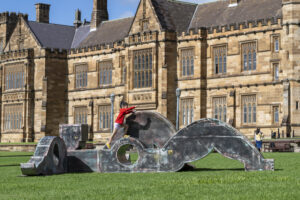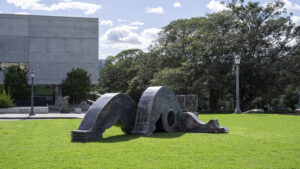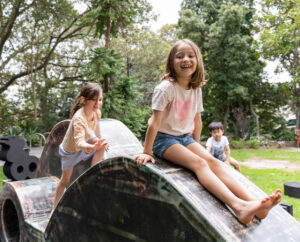Sanné Mestrom on Monumentality, Playable Sculpture and the Female Form
Harnessing the monumental exhibition spaces within the Melbourne Convention and Exhibition Centre and curated by Shelley McSpedden, Senior Curator, Australian Centre for Contemporary Art (ACCA), BEYOND presents four large-scale installations and spatial interventions that respond to the Fair’s thematic, ketherba/together.
Melbourne Art Fair had the opportunity to speak with artist and academic Sanné Mestrom, to discuss her interactive work for BEYOND, challenging the ‘look but don’t touch’ conventions of artworks shown in an exhibition space, and balancing monumentality, permanence and precision within her practice.
Sanné’s work will be presented by Sullivan+Strumpf (Gadigal Country/Sydney, Naarm/Melbourne, Singapore).
Your work for BEYOND, titled The Whole is Greater Than the Sum of Her Parts (2023) presents the figure of an abstracted female form in a state of semi-repose. Can you expand on your engagement with female representation in western art history and through your own personal journey of motherhood?
Throughout my practice, the bold monumentality of the female nude, epitomised by artists like Henry Moore and Picasso, has been a source of fascination. Icons such as Kathy Kolowitz, Niki de Saint Phalle, and the ancient Venus of Willendorf further enriched my appreciation. I have always had pictures of these works pinned to my studio wall, and eventually went out in the world to see them for myself in France, New York, Berlin.
There’s an inherent audacity in these figures, an almost absurd, comical quality in the often lumpy grotesqueness of their forms. With Moore and Picasso, however, the allure is tainted by their wildly inappropriate reclining nudes, perpetuating objectification, endorsing passive stereotypes that reinforce traditional gender roles and prioritise the male gaze, contributing to a history that sidelines female perspectives and autonomy.
In 2013, I introduced figuration into my practice with a commission for ACCA. The result was the creation of a massive water fountain named ‘Weeping Woman,’ standing at a towering 3.5 meters. This abstracted nude, leeching water across the museum floor, directly referenced Picasso’s controversial ‘Weeping Woman’ painting of 1937 (held in the NGV collection). The piece aimed to reclaim the power of the female body in a contemporary museological context, critiquing Picasso’s work of the same name, for portraying women as passive victims of suffering.

The narrative of my art took a personal turn after becoming a mother in 2017. The female nude, once a political statement, evolved into a deliberate and intimate expression. Motherhood marked a profound shift – my body was no longer my own. Every part of me now served a purpose, a duty to the world and the people in my life. The physical enactment of my creative process became a rumination on my maternal body, pulled in multiple directions as I juggle sustaining my family and nurturing my art practice.
As a mother, the classic image of the working mum emerged: one arm cradling a wriggling toddler, the other laden with grocery bags, kicking a car door shut with my foot, and a phone pressed against my shoulder. Every bit of my being now has a job to do – my brain as an academic, my body as an artist, and my heart as a mum. It’s fulfilling and relentless in equal measure.
At the same time, my sculptural objects transitioned from inert forms to active participants. They assumed a responsibility to other objects and the world at large. Believing they should ‘function’ in the world, I began making sculptures that are climbable, sittable, or in some discrete way ‘usable.’ This intentional approach aims to contribute to the dynamism of everyday life, the works no longer merely ‘take’ from the world by occupying space or time. Instead, these sculptures are intended to give back to the world, engaging with and enhancing the lived experiences of those who encounter them.
Can you describe the process of designing and physically creating this work? How does your work as an academic inform your approach?
I’m an academic at the University of Sydney (Sydney College of the Arts) and in 2022 I was awarded a four year fellowship from the Australian Research Council for a project called ART/PLAY/RISK. I designed this project to bring together my interest in public art, with my interest in creating more child-friendly cities, it’s focuses on the role that public art can play in creating intergenerational future cities. It neatly dovetails both my art practice and my academic career, which is something I’ve had to do by necessity: as a fulltime working single mum I have to be super-efficient with my time and energy, so bringing my interests together in this way was the perfect solution.
In practical terms, my process for designing large sculptures, particularly public art works, begins with continuous sketching in journals and on large sheets of paper. These sketches experiment with capturing the female form, from which I extract patterns and shapes for maquettes. These maquettes, often ceramic or small wooden blocks, serve as the foundation for my ‘design team’ at Wednesday Studios. Together, we address logistics like scale and engineering, producing detailed design drawings. The fabrication team then takes over, working across materials like bronze, concrete, and fiberglass to construct the final pieces. The entire process, depending on scale, spans from 3 months to 3 years.

Can you elaborate on the significance of scale within your works and the relationship they have to the environment around them? How do you navigate the balance between monumentality, permanence, and precision?
I know that bigger is not always better, but damn I love working large. I love working alongside fabricators and being as hands-on as possible in the workshops. Being a ‘soldier-on-the-ground’ involves problem solving any number of issues that arise. The fabrication process of large-scale works is a realm that is completely dominated by men, so it feels great to carve a little place of my own in here. And I love working as a team, absorbing some of the wisdom of the incredible fabricators I work with, which also helps me understand the hidden logic of certain design-considerations which can be carried over into future projects.
Balancing monumentality, permanence, and precision when up-scaling poses challenges. I have found it is quite difficult to up-scale a work without losing the intimacy of smaller-scale pieces. I try to tackle this by combining specific materials such as concrete (an industrial material) with bronze (a traditional art material). For example, I might insert a hand-cast bronze element that embodies my fingerprints into a large concrete cast work, as a way to maintain a softness and intimacy at a larger scale.
Over the course of your career, your practice has embraced a wide range of disciplines, including public art, play, architecture, and natural phenomena. How has your exploration of the intersection between art, play, the body and the public sphere evolved throughout your career?
I’ve always envied artists that find a groove in their art practice early on and just stick to it – fine tuning it over a lifetime. But I know I could never do this. In my art practice, and in my life more generally, I am always seeking new horizons. As I’ve evolved as a person, a woman, and a mother, my work has adapted accordingly—sometimes leading, sometimes following; perhaps this is why I’ve lived in so many places around Australia and around the world, and why I’ve practiced my art across so many different disciplines. I’m very adaptable and my work completely absorbs my surroundings: if I have a small studio, the scale of my work will reduce, in a large studio, it’ll expand. If I have access to a kiln or a welder, a library, or a wood workshop, my work will utilise these. I love learning new skills, and learning from old-school pros. I always take the long-term view to life and art, and ultimately, when pulling the lens right back, perhaps everything I’ve ever made is slowly moving in the same direction. Maybe the red-thread that runs through my practice will make more sense when I’m 80, if I ever get that far.

All photographs courtesy the artist and Sullivan+Strumpf (Gadigal Country/Sydney, Naarm/Melbourne, Singapore).
With The Whole is Greater Than the Sum of Her Parts presented at Melbourne Art Fair, self-directed engagement is encouraged between the viewer and the sculpture. How do you anticipate the sculpture’s dialogue with the audience, both physically and conceptually? Given the unpredictable nature of public engagement, do you see the act of interaction as an integral part of the artwork itself?
There is a hidden contract in all art that we can look but not touch. My work seeks to challenge this convention, so public interaction is essential to the work.
rom my experience, children will naturally want to climb The Whole is Greater Than the Sum of Her Parts. The work has been designed with “hidden affordances” that will speak directly to kids. For example, the height of various parts of the sculpture respond to the scale of kids aged 5 – 12 years old. The various slopes or ‘gradations’ of the legs, for example, will appeal to kids of different abilities and risk-appetites (from a very shallow slope through to a steep slope). While at first glance the shape of the reclining figure appears to be quite straight forward, upon closer analysis you’ll find that a lot of thought has been put into the design to create aspects that are climb-on-able, sit on-able, jump overable, jump down-offable, hide in-able, hide behind-able, slide down-able. As adults we may not recognise these affordances immediately, but kids definitely will! That said, I’d love the work to invite adults to interact with it too!


